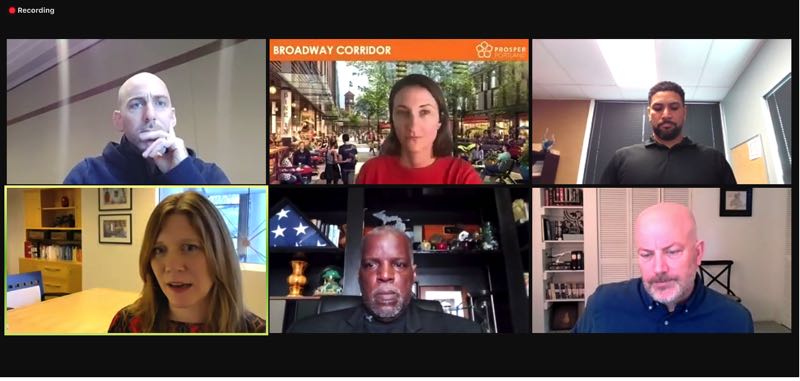By Jim Redden
Portland Tribune
Publication date: January 12, 2022
Politics, leadership and compromise needed to take advantage of federal funding, some leaders say at Tuesday forum.

The greater Portland region has the opportunity to invest $10 billion in a series of transformational public and private construction projects in coming years. Much of the funding could come from the bipartisan federal Infrastructure Investment and Jobs Act approved by Congress. But those involved with some of the projects worry that local political disagreements could derail them.
“This region has lost the art of the compromise. It has lost its way and is looking for someone to lead the way,” Oregon Transportation Vice Chair Alando Simpson told the Portland Business Alliance on Wednesday, Jan. 12.
Simpson was speaking about the I-5 Rose Quarter Improvement Committee, where he chairs its executive committee. As a Black man, Simpson said he understands the distrust that was created when I-5 was built through the historically Black Albina Neighborhood in the 1960s. But he said that distrust is now threatening the potential once-in-a-generation investment of federal infrastructure dollars.
“Compromise has to be the North Star,” said Simpson, who is also owner and CEO of City of Roses Disposal & Recycling.
Simpson spoke at a breakfast forum titled “Cranes on the Horizon: Portland’s Next Construction Boom.” His concerns were echoed by Greg Johnson, program coordinator for the Interstate Bridge Replacement Program. It is the successor to the Columbia River Crossing Project that failed to reach agreement on how to replace the aging I-5 bridge between Oregon and Washington several years ago.
“The passion here for different things is admirable, but at some point we have to get things done. Environmental issues are not getting any better, and not doing anything has not improved anything in this (transportation) corridor,” said Johnson, who is trying to balance the demands of multiple agencies and advocacy organizations in both states.
Three other projects discussed at the forum do not face the same political problems as the freeway-related ones but are still facing challenges.
Port of Portland Executive Director Curtis Robinhold discussed the $2,5 billion expansion of Portland International Airport known as PDX Next. He said that with $1.5 billion already spent, construction costs are increasing rapidly because of inflation.
“Cost increases are facing all of us. Everything has gone through the roof, up double digits and more. And we’ve lost 10 to 20 percent of our contract teams to COVID, so there are a lot pressure we have to deal with.”
Prosper Portland Executive Director Kimberly Branam said the economic uncertainty created by the pandemic has unsettled the Broadway Corridor Project that envisions creating a new urban neighborhood on 14-acres at the southern end of the Broadway Bridge that includes the former U.S. Post Office. Although the City Council has approved a master plan that calls for the construction of 4 million square feet of housing, offices and retail space, the developer quit last September amid deteriorating market conditions.
“We always thought it would be a multi-business cycle project, but we’re in a difficult spot,” said Branam, who predicted a process for selecting a replacement developer will be finalized in coming months. In the meantime, Branam added, work preparing the site for development is expected to proceed and take two to three years to complete. It includes demolishing the post office and reconfiguring Northwest Johnson and Kearney streets in the area.
OMSI President and CEO Erin Graham is not yet facing such problems with the planned redevelopment of the organization’s property in the Central Eastside. The first renderings of the OMSI District were only unveiled last December. They envision a mixed use development with up to three million square feet of new housing, office space and retail, along with a focus on education and reestablishing a Native American presence along the waterfront.
But, Graham said, financing the work will be more difficult because OMSI is a nonprofit organization with a science mission, not a government agency with construction experience.
“OMSI does not receive city or state funds,” Graham said.
The forum was moderated by PBA President and CEO Andrew Hoan, who asked each of the panelists to predict how their project will benefit the region in 10 years.
Simpson said a successful I-5 Rose Quarter Improvement Project would be an international model for sustainable economic development. Johnson said the replacement I-5 bridge would create a multi-modal corridor the offers greener ways to cross the Columbia River. Robinhold said the airport terminal will be larger but more energy efficient and easier for people with different abilities to get around. Branam predicted the Broadway Corridor would be a great urban neighborhood that connects the Pearl District to Old Town/China Town. And Graham said the completed OMSI District will help revitalize the Central Eastside.
Source: The Portland Tribune